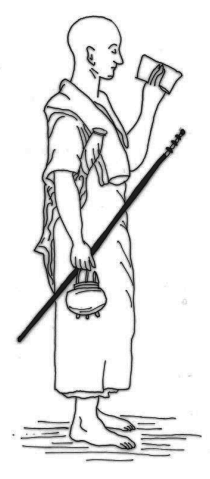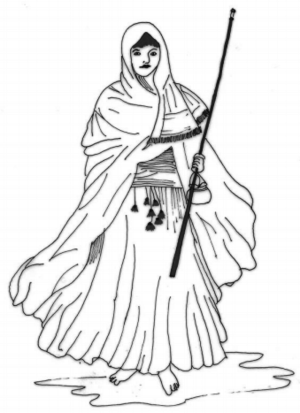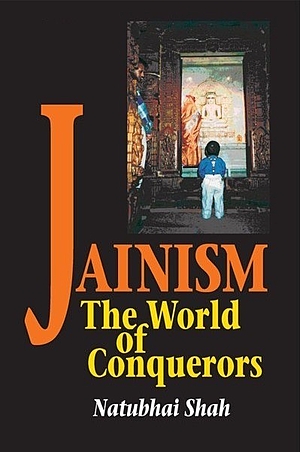The Jain community consists of the fourfold order established by Mahavira and is commonly known as the Jain Sangha. The term Sangha embraces the four orders of monks (saadhus), nuns (saadhvis), laymen (sraavakas) and laywomen (sraavikaas), in fact the whole Jain community. The Jain Sangha is involved in all major decisions affecting the community and has supreme authority over the individual orders. The ascetic order plays a very important part in Jainism; it observes the teachings of Mahavira rigorously. It is impossible for laymen and women to follow the teachings to the same extent, as they are involved in worldly activities and in earning their livelihood, however, they follow the teachings of Mahavira to the best of their ability.
Throughout the centuries monks have been the scholars and teachers of the Jain faith. Nuns have been much less involved in scholarship but have taken a prominent part in expounding the faith to the laity. The monks have not only produced work of a religious nature but have also created scholarship of importance in science, medicine, mathematics, logic, languages and other fields of study. This tradition continues today. Lay scholarship has also developed considerably in recent times. One has to admire the genius of Mahavira and his followers for the fact that after more than 2,500 years this fourfold organisation of Jains is still very much in evidence. Mahavira respected the
Sangha as if it was a Tirthankara and the faithful do likewise. There is both respect and indirect control of one order over the other. The laity respect and learn Jain teachings from the ascetic order, and the monks and nuns respect and listen to the laymen and women.
The career of Jain monks and nuns begins with the ceremony of initiation into asceticism (diksaa) by acceptance of the obligations of the five great vows, and continues unbroken to the end of their lives. The ascetic state is a permanent commitment; the discipline is strict, yet, those who leave ascetic order are few. The monks and nuns inspire the laity to establish temples, upashrayas, libraries and other welfare institutions for the community.
Although the mendicant order is seen as unitary, it has for very many centuries been divided into many stems or groups (gaccha, gana). These groups may take their names from their place of origin, from association with a particular caste, from their founders or from particular points of doctrine or ritual. The gaccha may be subdivided, most commonly into groups studying under particular teachers. References to these divisions of the mendicant orders are found around the eighth and ninth centuries CE and some of these exist today: the Tapaagaccha, Kharataragaccha and some other gacchas can trace the line of succession of their leaders back through a long history. The practice of solitary religious retreat is known in Jainism, but usually the Jain monks and nuns are to be seen as a member of a group, attached to their spiritual leader or guru. Although study, scholarship and preaching are important activities of the mendicant order, the primary aim of the monk or nun is the purification of his or her own soul, and it is to this end that all the austerities and disciplines are directed. The rigours of the mendicant life mean that relatively few people enter it, which is particularly true of the Digambars.
Figure 5.1 Svetambar 'monk'

Figure 5.2 Svetambar 'nun'

The total number of Digambar monks in the mid-1990s were 295 and aaryikaas (saadhvis) 250, while Svetambar monks and nuns were estimated to number over ten thousand (see table 5.3)
Table 5.3 Number of Jain saadhus and saadhvis resident for the four-months of the rainy season in 1995
| Sect | Aacaaryas | Saadhus | Saadhvis | Total |
| Svetambar Murtipujaka | 123 | 1,374 | 4,961 | 6,335 |
| Sthanakvasi | 8 | 512 | 2,492 | 3,004 |
| Terapanthi | 1 | 146 | 545 | 691 |
| Digambar | 33 | 295 | 250 | 545 |
| Total | 165 | 2,327 | 8,248 | 10,575 |
Among the Digambars, 'semi-ascetics' (bhattarakas) undertake some of the religious functions, which in the Svetambar sect are carried out by monks and nuns. In the past, Svetambars had the institution of 'semi-ascetics' (yatis), who performed socioreligious functions such as disseminating Jain teachings, the installation ceremony of the images in the temples, a community pastoral role, but today there are very few yatis and this institution has practically disappeared.
In the 1980s, Aacaarya Tulsi of the Terapanthi sect developed a community of samanas and samanis, who take partial vows, can use a vehicle for travel, cook and use modern toilets; otherwise their lifestyle is similar to monks and nuns. They have travelled to the West and play an important part in propagating Jain values.
The present Jain population in India is difficult to estimate, but is no more than one percent of the total population; it was much larger in the past. It has succeeded in maintaining its separate identity. Jains have a distinctive outlook on life embracing ethical rules of conduct based on non-violence and reverence for all forms of life. Jain ethics, places of worship, scriptures, holy days, rituals, ascetics, history, philosophy and culture are recognisably different from their Hindu counterparts, and these differences are seen, for example, in the observance of certain widespread customs and the underlying aims of those customs. For Hindus, marriage is a religious sacrament, while Jains consider it a civil contract. Hindu culture observes a number of days of mourning for the dead, Jain teachings run counter to this. Unlike Hindu practice, in the Jain tradition a widow inherits the property of her deceased husband. Hindus consider adoption a religious matter, Jains do not. However, one can often see the influence of Hindu customs on the social life of some in the Jain community. In the case of Jains who were formerly members of Hindu castes, the persistence of these non-Jain customs may be attributed in part to their previous social, cultural and religious lives. There is no doubt of the impact of certain cultural influences on Jains from the wider Hindu community.
The Jain community in India has been historically influential and has been able to play a significant role in the economic and national life of India. Even though numerically a minority, Jains has always had considerable prestige and produced a large number of eminent personalities. Their religious beliefs, particularly their commitment to 'non-violence' has circumscribed the types of profession or business in which they will engage. This has led to Jains having a disproportionate representation in banking and finance, accountancy and management, medicine and law, and some trading and commerce. The consequence of this economic specialisation has been that the Jain community has become very wealthy. This wealth has enabled Jains to undertake extensive philanthropic projects, both in India and beyond, and for the benefit of nonJains as well as for Jains.
Despite the many successes of the Jain community, there remain problems: the common religious bond is not strong enough to prevent divisions, which have sometimes led to schisms; these divisions undermine the community. What is true of religious divisions, is equally true of social divisions: traditionally, Jain social organisation is viewed as having originated in the distinctions of work and function, but later, under Hindu influence, a large number of castes and sub-castes emerged among Jains.
Jain Social Structure
Since the time of Mahavira, people of different castes (varnas) and sub-castes (jaatis) from various areas have accepted the Jain religion, making the Jain society heterogeneous. Thus, the Jains are a community, or rather a grouping of communities, as well as followers of a religion, and as they originated from different backgrounds, they organised themselves into differing groups known as jnati or naat to facilitate the smooth functioning of society. In the West, where individual mobility between religions and social groups is commonplace, the nature of Indian society, with the individual bound by group ties to his or her own community and following the same customs and worshipping the same gods, is not always understood.
Jain society is organised into more than 200 jnati groups, more than 100 major groups among Svetambars and about 80 major groups among the Digambars. The names of different groups are based upon places of origin (sometimes of ancestors many centuries before), rivers, natural surroundings, and professions. Many social sub-groups were formed based on profession, such as Shah (moneylender), Bhandari (treasurer), Mehta (accountant), Gandhi (grocer), Kapadia (cloth merchant) and Jhaveri or Zaveri (diamond merchant). One also finds 'sub-names' like Sanghavi (pilgrimage organiser) based other than on professions. The second quarter of the twentieth century saw a move towards changing the family name to 'Jain', a surname for a distinct Jain identity in the official census data. This has not been universally adopted, but in some areas of northern India it is now an established practice. The most prominent of these groups are found among Hindus (H) as well as in both major sects of Jains Svetambars (S) and Digambars (D), as shown in the table below.
Table 5.4 The origin of Jain groups
| Name | Origin | H/S/D | Sub-Groups |
| Shrimali | Srimala (Bhinmala,Rajasthan) | H/S/D | 3 |
| Agrawal | Agroha (Haryana) | H/S/D | 18 |
| Oswal | Ossiya (Rajasthan) | H/S/D | 18 |
| Porwad/Porwal | Eastern side of town | H/S/D | 24 |
| Khandelwal | Khandela (Rajasthan) | H/D | 84 |
| Parwara | Eastern side of town | H/S/D | 144 |
| Setvala | farmers, Ksetrapalas | H/D | 44 |
| Upadhye | Priest | H/D |
Among Srimalis one finds three sub-groups: Dasa, Visa and Ladava, while among Oswals one finds mainly Dasa and Visa. Another aspect of Jain social organisation is the gotra, whereby, membership of a particular gotra identifies one's blood relationship, the word originally meaning an enclosure for cows, but eventually it was extended to mean the family lineage. The gotra embodies the limit on endogamous relations, and no two people may marry if they belong to the same gotra.
The functions of the different social groups have always been fivefold:
- to make rules for the smooth organisation of the group;
- to (s)elect trustees known as mahaajana, for enforcement of the rules;
- to maintain religious and social liaison with the wider Jain community;
- to aid group cohesiveness, marital and social relations, amity and the prosperity of its members;
- to settle disputes between members, and to discipline any offenders who breach the rules of the group.
The groups provide facilities such as rest houses, boarding houses, educational institutions and other philanthropic services mainly for their members, although nonmembers are not excluded. In modern times, because of migration and social change in India, these groups are losing the importance and their function is diminishing.
Because of their background, Jains have different socio-religious customs; rules regarding marriage and rituals such as the sacred-thread, tonsuring and worship of family deities; hence outsiders often find little difference between Hindus and Jains. Moreover, many still follow the social customs modelled on Hindus, making the identity of Jains problematic.
Marriage
Marriage is perhaps the most important social custom in any society. Jain philosophy places more emphasis on renunciation and asceticism, but it would be a mistake to suppose Jainism is anti-marriage, on the contrary, marriage is considered as a social duty for a Jain layperson.
Jain marriage is usually within the community, among members with similar backgrounds, where the couple has a free choice to agree to the proposal. The community not only witnesses the union but also helps in overcoming future misunderstanding. In Jain society, the marriage is usually permanent, but it can be nullified by a mahaajana, if either of the couple finds a major defect in the partner within a prescribed time such as unchastity, impotence, or intolerable behaviour; if the spouse absconds or disappears; or becomes an ascetic, or dies. Though they are permitted, most women do not remarry, instead they involve themselves in the religious and spiritual life, but many men remarry.
Divorce in Jain society is very rare. Intercaste marriages within different Jain communities or with other religious communities are not penalised, sometimes they are accepted and blessed by the community leaders. Widow marriages are permitted in some caste groups (setvalas). Pre-marital relationships bring discredit to families and are discouraged.
Jains in the Contemporary World
The heterogeneous character of the Jain community has helped Jains adjust and accommodate to the other groups among whom they live, at home or abroad, without their losing their cultural and religious identity. In spite of their being a minor community, Jains have an influence out of all proportion to their numbers in the societies in which they reside. The migration and the complexities of life have added strains to the functioning of Jain society. In the West, it is a norm for both the parents to work and Jains are no exception to this; they spend less time with their children and, as a result, one finds a diminishing interest in the traditional culture among the young. Western educational institutions prepare a pupil to be independent; media and peer pressure the younger generation; Jains have failed to provide an infrastructure for traditional learning and leisure and, as a consequence Jain society is under severe strain. Jains find it difficult to locate acceptable schools, canteens, restaurants and other public places. Some, because of non-availability or because of their companions, have begun to accept food contrary to their acceptable norms. This has become a worrying sign for the Jain community.
Very few people in the West know the word 'Jain' or have heard of Jainism. Jains are mistaken for Hindus, although Jains work hard to establish their own identity, but due to lack of infrastructure the results are not as encouraging as one would have wished, and Jains still face adjustment problems: socio-cultural, religious, educational and care of the elderly.
Socio-cultural: Economic gains have created strains to Indian family life: The greater economic freedom of women has raised their expectations of a better life, and many men are unable to adjust to this novel situation, which has brought tensions to families, and affects their children. Jains spend most of their spare moments in socialising, leaving hardly any time for the welfare of their community. This is a worrying phenomenon when attempting to maintain the values of a traditional Jain society.
The modern environment has created situations, which are not discussed in the scriptures, but these new inevitable problems can be resolved on the basis of the principles of non-violence, non-attachment and Jain ethics. Take family planning for example: scriptures advocate sexual restraint and celibacy, which aided family planning, but as it is difficult to observe in a modern complex environment, contraception may be necessary. If contraception has to be used, it should be accepted with regret as a lack of self-control.
Abortion is another problem with physical, psychic and demographic factors. Jainism believes life starts on the day of conception and does not sanction abortion, as it involves the murder of a human being. However, the texts describe the methods of abortion in rare physical or mental circumstances where mother's life is likely to be in danger (Jain N 1996: p.549).
Alcohol, tobacco, and drugs such as cannabis, heroin or cocaine affect one's health, wealth and society, and produces violence. The scriptures sanction only a vegetarian diet involving minimum harm even to plant life and practically all the members of the Jain community subscribe to it.
Religious problems: Coming to the West has deprived Jains of two orders of the sangha, i.e. monks and nuns, regular places of worship and religious activity. Many Jain centres have been established in the West, but they lack a cohesive infrastructure and the presence of spiritual leaders. Jains have now seriously begun to discuss this problem of providing an infrastructure and spiritual leadership seriously.
Educational problems: Most of the Jains coming to the West had their primary religious training in the local Jain schools in India, attached to temples or upashrayas. Children born in the West have no such opportunity, as there is lack of teachers, traditional schools and the literature. Jains need an appropriate literature especially written for the children in a Western language, style and content, and facilities to learn their 'mother tongues', especially Gujarati and Hindi, where most of the Jain literature is available, and the knowledge of what is needed for cultural contacts within families, the community, and their place of origin.
Problems of the elderly: In the West, people are generally independent, family values are under pressure, and the elderly are cared for far less by family members. This is contrary to Indian cultural values and as a consequence earlier migrants, now grown older, have started to experience isolation. Despite the fact that their physical needs may be cared for by the state, which means the elderly people are not dependent on their family, they are suffering emotionally. Fortunately, this problem is not acute among Jains, as young Jains still respect their elderly, and the elderly have adjusted to the situation, but sooner or later they will require an infrastructure to aid pass their leisure time and provide for their socio-religious needs.
 Dr. Natubhai Shah
Dr. Natubhai Shah
